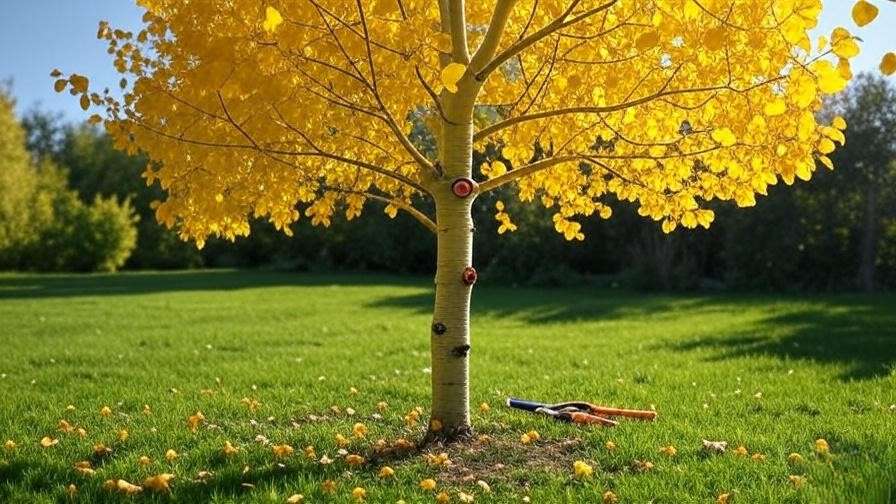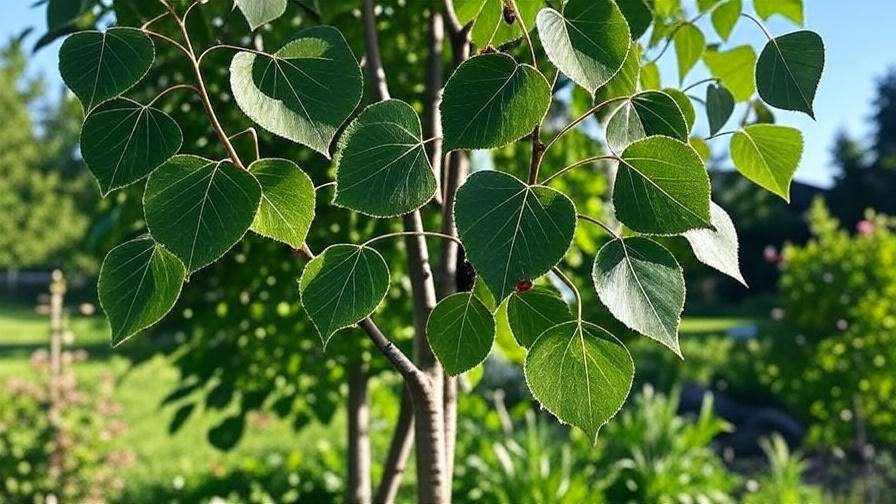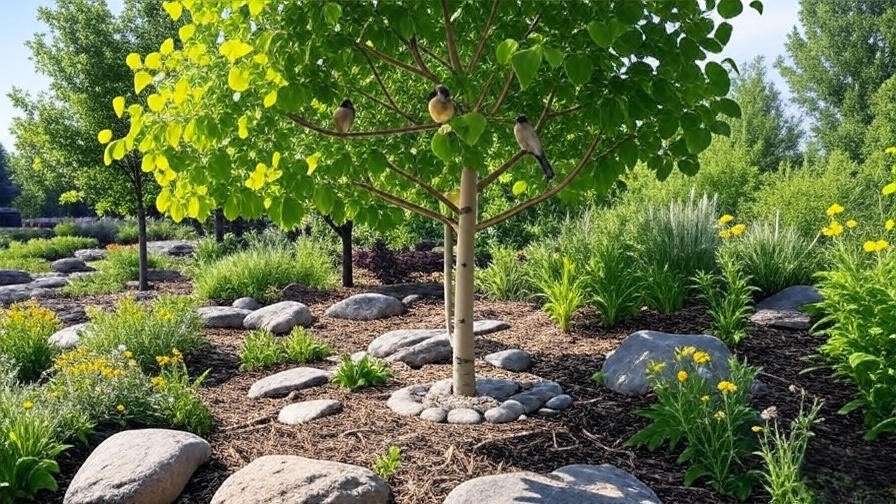Imagine standing in your garden, surrounded by the gentle rustle of shimmering leaves dancing in the breeze, their golden hues catching the autumn sun. This is the magic of the Swedish aspen tree (Populus tremula ‘Erecta’), a stunning, columnar tree that’s stealing the hearts of gardeners and landscapers alike. Whether you’re a novice gardener or a seasoned arborist, growing a Swedish aspen tree can transform your outdoor space with its slender elegance and ecological benefits. But how do you ensure this unique tree thrives in your landscape? In this comprehensive guide, we’ll walk you through everything you need to know to plant, care for, and maintain a healthy Swedish aspen, drawing on expert insights and proven horticultural practices. From choosing the perfect planting spot to tackling common challenges, this article is your go-to resource for a flourishing Swedish aspen tree 🌿.
What is a Swedish Aspen Tree? 🌿
Botanical Overview and Characteristics
The Swedish aspen tree, scientifically known as Populus tremula ‘Erecta’, is a cultivar of the European aspen, prized for its narrow, upright growth habit. Unlike its spreading cousins, this tree grows tall and slim, reaching heights of 30–50 feet while maintaining a width of just 5–10 feet. Its heart-shaped leaves tremble in the slightest breeze, creating a mesmerizing visual and auditory effect 🍂. In fall, the foliage turns a vibrant gold, making it a standout in any landscape. The “Swedish” moniker reflects its popularity in Scandinavian landscapes, where its cold-hardiness shines in harsh winters ❄️.
Benefits of Growing Swedish Aspen Trees
Why choose a Swedish aspen? Beyond its aesthetic charm, this tree offers practical benefits. Its compact form makes it ideal for small yards, urban gardens, or as a natural privacy screen. Ecologically, it supports wildlife by providing habitat for birds and pollinators 🐦. Swedish aspens also contribute to carbon sequestration, making them a sustainable choice for eco-conscious gardeners. Compared to other aspens, their controlled growth reduces the risk of invasive root suckering, offering a low-maintenance option for busy homeowners.
Why Choose a Swedish Aspen Tree for Your Garden? 🌸
Ideal Growing Conditions
Swedish aspens thrive in USDA hardiness zones 2–7, making them perfect for colder climates like those in northern Europe or North America. They prefer well-drained, loamy soils with a neutral to slightly acidic pH (6.0–7.0). Full sun exposure is crucial for vibrant foliage and strong growth, so aim for a spot with at least 6 hours of direct sunlight daily ☀️. While adaptable, these trees struggle in waterlogged or heavily shaded areas, so site selection is key.
Versatility in Landscaping
The Swedish aspen’s slender profile makes it a versatile addition to any garden. Use it as a striking focal point, a windbreak, or in rows for a natural fence. Its upright growth fits perfectly in tight spaces, such as along driveways or property lines. For inspiration, consider a Scandinavian-inspired landscape with Swedish aspens paired with low-growing perennials like lavender or ornamental grasses. This combination creates a modern, low-maintenance aesthetic that’s both functional and beautiful 🌾.
How to Plant a Swedish Aspen Tree 🌲
Choosing the Right Time and Location
Timing is everything when planting a Swedish aspen. Early spring or fall is ideal, as cooler temperatures allow roots to establish before summer heat or winter frost. Choose a location with full sun and well-drained soil, avoiding low-lying areas prone to flooding. Ensure the site has enough vertical space for the tree’s mature height and minimal competition from nearby trees or structures.

Step-by-Step Planting Guide
- Test the Soil: Use a soil testing kit to confirm pH and nutrient levels. Amend with compost or organic matter if needed to improve drainage.
- Dig the Hole: Make the hole twice as wide and as deep as the root ball. This ensures ample space for root expansion.
- Plant the Tree: Place the tree in the hole, ensuring the root collar sits level with the soil surface. Backfill with soil, tamping gently to remove air pockets.
- Water Thoroughly: Water deeply after planting to settle the soil and encourage root growth 💧.
- Mulch: Apply a 2–3 inch layer of organic mulch (like wood chips or bark) around the base, keeping it away from the trunk to prevent rot.
Expert Tips for Success
- Stake Young Trees: Use stakes to support the slender trunk during the first year, especially in windy areas.
- Mulch Wisely: Refresh mulch annually to retain moisture and suppress weeds, but avoid piling it against the trunk.
- Check Drainage: If your soil is clay-heavy, consider raised planting or adding sand to improve drainage.
Caring for Your Swedish Aspen Tree 🌞
Watering Requirements
Young Swedish aspens need consistent moisture to establish strong roots. Water deeply once or twice a week during the first year, providing 1–2 inches of water depending on rainfall. Established trees are more drought-tolerant but benefit from supplemental watering during prolonged dry spells. Avoid overwatering, as soggy soil can lead to root rot, a common issue with aspens. Use a moisture meter to gauge soil conditions if unsure 💦.

Fertilizing for Optimal Growth
Fertilize in early spring with a balanced, slow-release fertilizer (e.g., 10-10-10 NPK) to promote healthy foliage and growth. Apply according to package instructions, typically 1–2 pounds per tree, spread evenly around the drip line. Avoid over-fertilizing, as excessive nitrogen can weaken the tree and attract pests. For organic options, compost or well-rotted manure works wonders. Test soil annually to monitor nutrient levels and adjust as needed.
Pruning and Maintenance
Prune Swedish aspens in late winter or early spring before new growth begins. Use clean, sharp pruning shears to remove dead, damaged, or crossing branches. Shape the tree to maintain its columnar form, but avoid heavy pruning, as aspens recover slowly from large cuts. To manage root suckers, which may sprout near the base, mow or clip them regularly to keep the landscape tidy. Always sanitize tools between cuts to prevent disease spread 🛠️.
Common Challenges and How to Overcome Them 🛠️
Pests and Diseases
Swedish aspen trees are generally hardy, but they can face pest and disease challenges. Common pests include aphids, which cause leaf curling, and leaf beetles, which chew holes in foliage. Regular inspection of leaves, especially in spring, helps catch infestations early. For organic control, use neem oil or insecticidal soap, applying in the early morning or late evening to avoid harming pollinators 🐝. Chemical pesticides, like those containing imidacloprid, are effective but should be a last resort due to environmental concerns.
Diseases like leaf spot (dark spots on leaves) and powdery mildew (white coating on foliage) can occur in humid conditions. Improve air circulation by spacing trees properly and pruning dense areas. For severe cases, apply a fungicide labeled for aspen use, following instructions carefully. Canker, a fungal disease affecting the bark, is trickier. Remove affected branches promptly and ensure the tree is stress-free with proper watering and nutrition to boost its resilience.

Environmental Stressors
The Swedish aspen’s tall, slender structure makes it susceptible to wind damage, especially in exposed areas. Stake young trees and consider planting in groups to create a natural windbreak. During drought, supplement with deep watering every 10–14 days, ensuring water penetrates the root zone. Conversely, avoid planting in areas prone to waterlogging, as excess moisture can weaken roots. In winter, protect young trees from frost by wrapping trunks with burlap and mulching heavily to insulate roots ❄️. Sunscald, where bark cracks due to temperature fluctuations, can be prevented by wrapping trunks or painting them with white latex paint.
Expert Insights
Dr. Anna Bergstrom, a Scandinavian arborist with over 20 years of experience, notes, “Swedish aspens thrive when given space to grow vertically without competition. Regular monitoring for pests and proper mulching can prevent most issues.” A case study from a Minnesota community garden shows that a Swedish aspen recovered from leaf beetle damage through consistent neem oil applications and improved soil drainage, highlighting the importance of proactive care.
Seasonal Care Tips for Swedish Aspen Trees 🍁
Spring and Summer Care
Spring is a critical time for Swedish aspens as they emerge from dormancy. Check for new growth and ensure adequate water, especially during dry spells. Apply a balanced fertilizer in early spring to support leaf development. Monitor for pests like aphids, which are most active in warm weather, and treat early to prevent outbreaks. In summer, maintain consistent watering and mulch to keep roots cool and moist. Inspect for signs of stress, such as yellowing leaves, and adjust care as needed 🌞.

Fall and Winter Preparation
As fall approaches, reduce watering to prepare the tree for dormancy. Apply a fresh layer of mulch (2–3 inches) to insulate roots against freezing temperatures. Wrap young tree trunks with burlap or tree guards to protect against sunscald and rodents, which may chew bark in winter. Remove fallen leaves to prevent fungal spores from overwintering. In colder climates, ensure the tree is well-hydrated before the ground freezes to support root health ❄️.
Year-Round Maintenance Checklist
- Spring: Fertilize, inspect for pests, prune lightly if needed.
- Summer: Water deeply, monitor for disease, maintain mulch.
- Fall: Reduce watering, apply mulch, wrap trunks for winter.
- Winter: Check stakes and wraps, clear snow from branches to prevent breakage.
Download a free PDF checklist at [insert website link] to keep your Swedish aspen thriving year-round!
Swedish Aspen Tree in Eco-Friendly Landscaping 🌍
Supporting Local Wildlife
Swedish aspens are a boon for biodiversity. Their trembling leaves attract birds like finches and sparrows, which nest in the dense foliage 🐦. Pollinators, such as bees and butterflies, are drawn to nearby companion plants, creating a thriving ecosystem. Plant Swedish aspens alongside pollinator-friendly species like coneflowers or bee balm to enhance your garden’s ecological value. The tree’s root system also stabilizes soil, reducing erosion in sloped yards.

Sustainability Benefits
Swedish aspens contribute to a greener planet by sequestering carbon and improving soil health through leaf litter decomposition. Their moderate water needs make them suitable for xeriscaping, especially in regions with dry summers. By choosing Swedish aspens, you’re investing in a low-maintenance, eco-friendly tree that enhances both your landscape and the environment. For maximum sustainability, pair with drip irrigation systems to conserve water 💧.
FAQs About Swedish Aspen Tree Care ❓
Q: How fast do Swedish aspen trees grow?
A: Swedish aspens grow moderately fast, adding 1–2 feet per year under optimal conditions. Growth slows after 10–15 years as the tree matures.
Q: Are Swedish aspens invasive?
A: Unlike some aspen varieties, Swedish aspens produce fewer root suckers, making them less invasive. Regular maintenance, like clipping suckers, keeps them in check.
Q: Can Swedish aspens grow in small yards?
A: Yes! Their narrow, columnar shape makes them ideal for small spaces, such as urban gardens or along fences.
Q: What are the best companion plants for Swedish aspens?
A: Pair with low-growing perennials like lavender, catmint, or ornamental grasses to complement their height and add visual interest 🌾.
Conclusion and Call to Action 🌟
The Swedish aspen tree is more than just a beautiful addition to your landscape—it’s a sustainable, low-maintenance choice that brings year-round charm and ecological benefits. With the right planting techniques, consistent care, and proactive pest management, your Swedish aspen can thrive for decades, transforming your garden into a serene, Scandinavian-inspired oasis. Start your journey today by following this guide, and watch your landscape flourish with the elegance of trembling leaves and golden fall hues 🍂.
Have you grown a Swedish aspen or have tips to share? Leave a comment below, subscribe for more plant care insights, or download our free Swedish aspen care checklist at [insert website link]. Let’s grow greener together! 🌳













